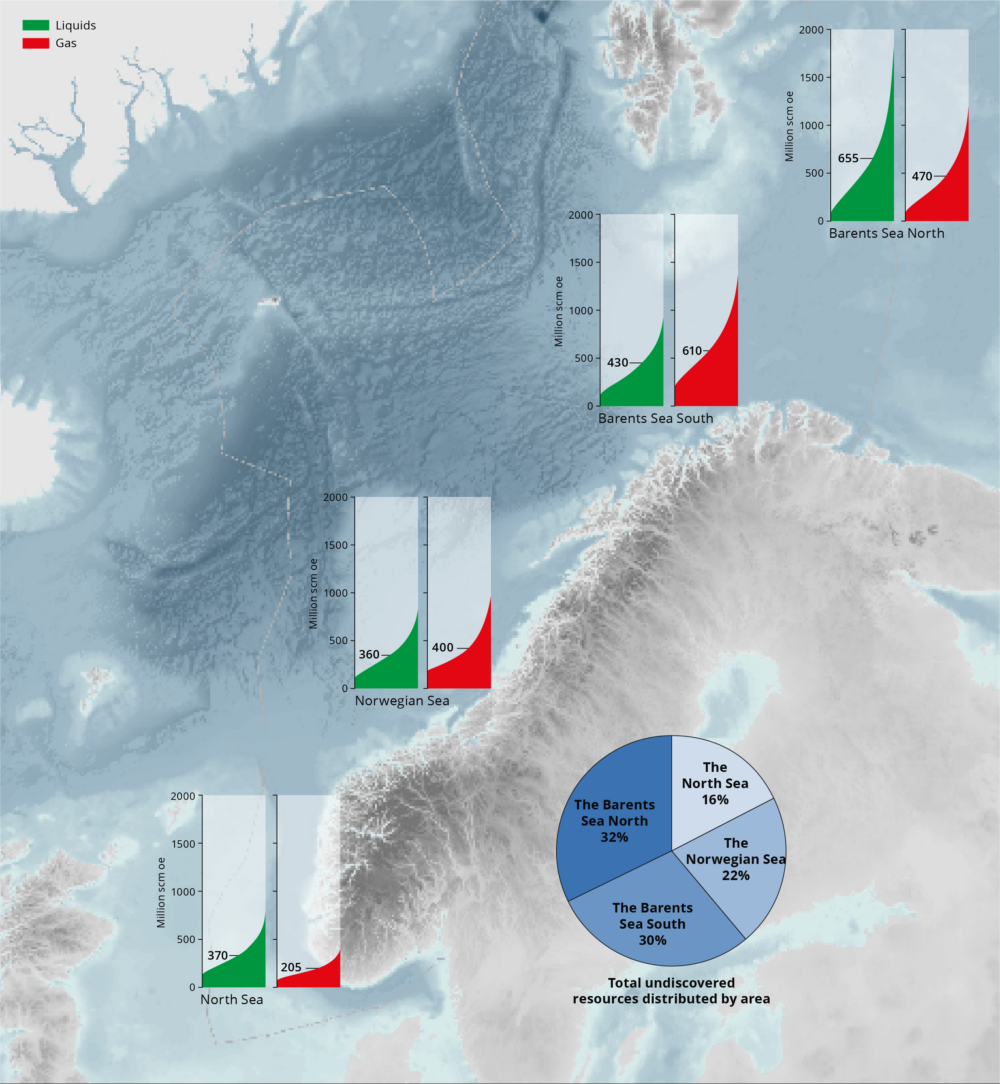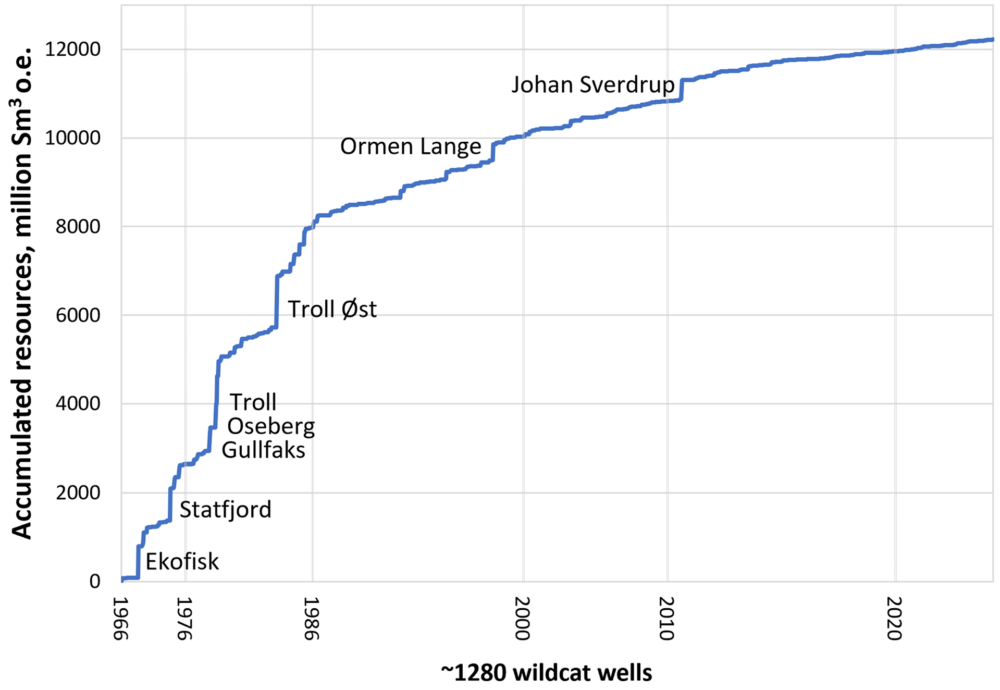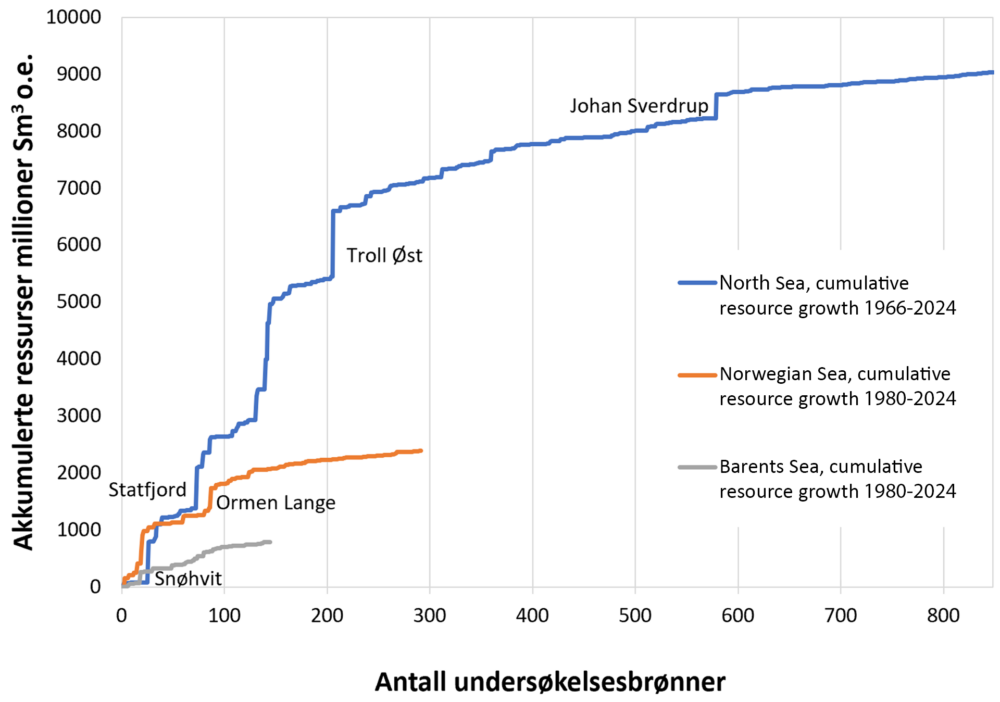New commercially viable discoveries are necessary to ensure the continuation of regular activities in the near future. This means maintaining exploration activity at a high level in all sea areas. It will also be important to make new discoveries in mature areas while established infrastructure is still in place and operational. Effective use of existing infrastructure makes it more likely that socio-economically profitable resources will be produced.
The Storting (Norwegian parliament) has opened most of the North Sea, the Norwegian Sea and the Barents Sea South (including Southeast) for petroleum activities.
The Norwegian Offshore Directorate has estimated the undiscovered resources on the Norwegian shelf at approximately 3.5 billion standard cubic metres of recoverable oil equivalents (Sm3 o.e.). This means that about half of all remaining resources on the shelf have yet to be proven.
Undiscovered resources are divided as follows between the different sea areas: 18 per cent in the North Sea, 21 per cent in the Norwegian Sea and 61 per cent in the Barents Sea.
Undiscovered resources by sea area
The figures in each column show expected recoverable volumes not yet discovered at year end. The uncertainty in the estimates is shown in the slanted line; low estimates on the left, high estimates on the right (Source: Norwegian Offshore Directorate).

The most attractive areas are explored first and the largest discoveries, with a few exceptions, were proven early on the Norwegian continental shelf. This is illustrated in the figure below as large increases representing Ekofisk, Statfjord and Troll, and then the curve gradually levels off. This is a normal development compared with other petroleum provinces. Ormen Lange and Johan Sverdrup prove that it is still possible to make large discoveries on the Norwegian shelf. The sea areas on the shelf have been explored to varying degrees.
Accumulated resources on the Norwegian continental shelf, 1966-2024
Source: Norwegian Offshore Directorate

About a total of 1280 wildcat wells have been drilled on the Norwegian shelf. In the North Sea, 834 wildcat wells have been drilled since 1966, and the vertical jumps in the figure show that the largest discoveries were made in an early exploration phase, such as Statfjord (1974) and Troll (1979). After this, the resource growth curve levels off somewhat; in other words, the discoveries become smaller, until we see a new jump with the Johan Sverdrup discovery in 2010. After Johan Sverdrup, the graph shows steady but moderate resource growth in the North Sea.
In the Norwegian Sea, exploration activity started in 1980, and 289 wildcat wells have been drilled up to now. Here too, the largest discoveries such as Heidrun and Ormen Lange were proven relatively early in the exploration phase, in 1985 and 1997, respectively. After Ormen Lange, there has been steady growth in resources, but with significantly smaller discoveries. Among the largest discoveries made in recent years are 6507/4-2 S (Dvalin Nord) in 2021, 7122/9-1 (Lupa) in 2022, and 35/10-10 S in 2023.
In the Barents Sea, exploration activity also started in 1980, but the area has considerably fewer wildcat wells (144) compared with the Norwegian Sea. The largest discovery so far is Snøhvit, dicovered in 1984. The graph shows that there have not been many large discoveries in the early exploration phase, as was the case in the North Sea and the Norwegian Sea. More than 60 exploration wells have been drilled in the last 10 years, with significant discovery success early in the period. The largest discovery in the last 10 years is 7324/8-1 (Wisting) in 2013.
Both large and small exploration companies have contributed to the strong resource growth in the last few years. Resource growth was particularly strong in 2010 due to the Johan Sverdrup discovery. This is the largest discovery in recent times and the fifth largest ever made on the Norwegian continental shelf. It was made in an area that has been regularly explored since the mid-1960s, and shows the considerable potential in exploration of mature areas.
In 2024, 42 exploration wells were completed on the Norwegian continental shelf. This is ten more than in 2023. In the North Sea, 30 wells were drilled, four more than in 2023; in the Norwegian Sea, six wells were drilled, one more than in 2023; and in the Barents Sea, six wells were drilled, five more than in 2023. Based on the companies' plans, approximately the same number of wells are expected in 2025.
There are two types of exploration wells: wildcat and appraisal wells. Wildcat wells are drilled to explore whether there are hydrocarbon deposits under the seabed. When a discovery has been made, appraisal wells may be drilled to obtain more data about the extent and size of the discovery. Of the 42 exploration wells completed, 28 were wildcat wells and 14 were appraisal wells.
Exploration wells spudded on the Norwegian continental shelf, 1970-2024
Updated: 09.01.2025
Source: Norwegian Offshore Directorate
Print illustration Download data Exploration wells spudded on the Norwegian continental shelf, 1970-2024 Download PDF Download as image (PNG)
High Contrast Mode
In 2024, 16 new discoveries were made, 11 of them in the North Sea, two in the Norwegian Sea and three in the Barents Sea. Two of the discoveries were made in development wells with exploration targets. The discoveries have a preliminary total estimate of 40 million standard cubic metres of recoverable oil equivalents (Sm3 o.e.). The largest discoveries in 2024 are 6605/6-1 S in the Norwegian Sea and 2/6-7 S (Othello) in the North Sea. Several of the discoveries are located in areas where they can be developed via existing infrastructure. Here, even small discoveries can contribute to significant value creation.
Gross resource growth and number of wildcats (completed), 1990-2024
Updated: 20.02.2025
Source: Norwegian Offshore Directorate
Print illustration Download data Gross resource growth and number of wildcats (completed), 1990-2024 Download PDF Download as image (PNG)
High Contrast Mode
468 wildcat wells have been completed between 2010 and 2024, resulting in 229 discoveries. These numbers show a success rate of about 50 per cent, which is high by international standards.
Exploration costs are expenses related to the acquisition of seismic data to map potential petroleum deposits beneath the seabed and the drilling of wells for further investigation. The elements of exploration costs are illustrated in the figure below.
Overall exploration costs and number of companies, 2000-2023
Source: Norwegian Offshore Directorate
Print illustration Download data Overall exploration costs and number of companies, 2000-2023 Download PDF Download as image (PNG)
High Contrast Mode
Several of the largest international companies have a central place on the Norwegian continental shelf. However, as areas have matured, new and more varied challenges have arisen. This has led to a change in the numbers and types of companies engaged in oil and gas activities on the Norwegian shelf. Generally low entry barriers to exploration on the Norwegian shelf encourage a diversity of companies and promote competition. The reimbursement scheme for exploration costs has been a contributing factor. High oil prices, exciting exploration areas, good exploration results and implemented measures by the authorities contributed to diversity, competition and exploration of the Norwegian continental shelf in the years 2002-2013. Since 2013, there has been a decline in the number of players, partly due to large international companies and European gas/power companies selling their interests on the Norwegian continental shelf in recent years.

